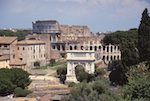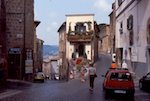Stacy and I went to Italy (her first time and my first time to Rome) to go to Andrew and Babetta’s wedding. It was our first trip abroad together.
The trip started in Rome at St. Peter’s which was started in 1506 and completed in 1626.
In the aftermath of the Battle of Actium (31 BC), Marcus Agrippa built and dedicated the original Pantheon during his third consulship (27 BC). That Pantheon was destroyed along with other buildings in a huge fire in 80 AD. The current building dates from about 126 AD, during the reign of the Emperor Hadrian. In 609 the Byzantine emperor Phocas gave the building to Pope Boniface IV, who converted it into a Christian church and consecrated it to Santa Maria ad Martyres, now known as Santa Maria dei Martiri.
The Colosseum, originally the Flavian Amphitheatre, is the largest amphitheatre built by the Roman Empire. Its construction started between 70 and 72 AD under the emperor Vespasian and was capable of seating 50,000.
The Palatine Hill is the centermost of the Seven Hills of Rome. It stands above the roman Forum, looking down upon it on one side, and upon the Circus Maximus on the other. Recent excavations show that people have lived there since approximately 1000 BC. Both in republican and imperial times it was the location of rich housing.
The Temple of Romulus was dedicated by Emperor Maxentius to his son Valerius Romulus. The ancient Roman fabric was Christianized and dedicated to Sancti Cosma et Damiano in 527, when Theodoric the Great, king of the Ostrogoths donated the library of the Forum of Peace and a portion of the Temple of Romulus to Pope Felix IV. The pope united the two buildings to create a basilica devoted to two Greek brothers and saints. The apse was decorated with a Roman-Byzantine mosaic, representing the Second Coming of Christ at the end of time.
Orvieto
This important Etruscan center later became a papal stronghold and it was here that Clement VII took refuge in 1527 when Rome was sacked by the French King Charles V.



































